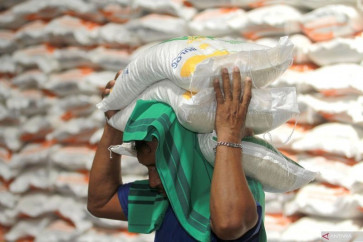Popular Reads
Top Results
Can't find what you're looking for?
View all search resultsPopular Reads
Top Results
Can't find what you're looking for?
View all search resultsAnalysis: Palm oil and coconut: Strategy to face EU’s RED II proposal
A recent initiative from the European Union to adopt Renewable Energy Directive II (RED II) has angered Indonesia and Malaysia, the two biggest exporting countries of palm oil
Change text size
Gift Premium Articles
to Anyone
A recent initiative from the European Union to adopt Renewable Energy Directive II (RED II) has angered Indonesia and Malaysia, the two biggest exporting countries of palm oil. The RED II initiative sets a renewable energy target of at least 32 percent for EU members by 2030. In the document, biofuels are listed as part of the EU’s strategy to increase renewable energy utilization in the economic bloc.
However, in order to achieve the target, RED II includes new frameworks and rules to ensure that biofuels are sustainable and do not cause deforestation from indirect change of land use of rain forests or grasslands. The EU argues that the expansion of palm oil plantation in Indonesia has contributed to 45 percent of deforestation in the country.
Altering high carbon stock areas into plantations has had a negative impact on biodiversity and created more greenhouse gas, among other things. For this reason, the EU classifies palm oil as an unsustainable source of biofuels. If the initiative is agreed by the EU Parliament and EU Council, the economic bloc will start to reduce palm oil use for biofuel in 2024 and completely phase it out by 2030.
Indonesia has anticipated these future obstacles by increasing domestic consumption and initiating a moratorium on palm oil plantation expansion last year. The mandatory 20 percent minimum proportion of vegetable oil in biodiesel seems effective to boost domestic consumption of palm oil and ease pressure on the trade balance deficit. Presidential Instruction No. 8/2018 halts all new proposals to open palm oil plantations and evaluates the existing ones as to whether they are located in conservation areas or not.
The government conducted those efforts, combined with all negotiation channels in ASEAN and the World Trade Organization (WTO), to convince Indonesia’s strategic partners that it is too early to classify palm oil as an unsustainable source of biofuel.
Moreover, the declining price and rising stock of palm oil have pushed the government to implement a minimum 30 percent biodiesel mixture (B30) policy. This action was followed by Malaysia, which aims to achieve B20 biodiesel by 2020.
The reason why the government is spending a lot of energy to counter the EU’s proposal is because the palm oil industry in Indonesia plays a vital role for economic growth, poverty alleviation and income distribution.
The total land area used for palm oil was approximately 12.3 million hectares in 2017, contributing 4.2 million direct and 12 million indirect jobs.
Palm oil has also become Indonesia’s top export commodity, and the EU is the country’s second-biggest export market after India and above China. Palm oil export to the EU was US$2.8 billion in 2017, equal to 15.1 percent of Indonesia’s total export of palm oil that year.
About 46 percent of imported palm oil worldwide went to biofuel, and the rest was for cooking oil and industrial use as well electricity and heating. Therefore, the proposal to scrap palm oil as a biofuel in EU member countries will significantly impact Indonesia’s palm oil industry.
Another option for the government is to seek alternative products for export that have the same potential as palm oil. Looking at coconut-related commodities could be the answer. Coconut trees live longer at 50 years and are therefore a cheaper investment. The commodity is also easy to take care of as it flourishes in tropical countries, such as Indonesia.
Coconut and its product derivatives have gained global popularity. Indonesia exported more than $550 million worth of coconuts to the EU in 2017, a 26.4 percent increase as the demand continues to grow.
However, domestically, the area of coconut plantations in Indonesia is shrinking, from almost 4 million ha in 2003 to 3.5 million ha in 2017. This trend was also reflected in total production, with Indonesia only producing 2.8 million tons of coconuts in the same year.
Nonetheless, there is a big discrepancy with the data from the United Nations’ Food and Agriculture Organization (FAO), which recorded 19.1 million tons of coconut production in 2014. This is probably the same old problem of the country lacking correct measurement of the total area and production of agriculture and plantation-based commodities.
Aside from that, Indonesia is one of the top three producers of coconut along with the Philippines and India. The opportunity to export coconut is wide open as worldwide demand is projected to reach $6 billion in 2020, according to food and beverages consultant Zenith Global.
The growing demand is also shown by an increase of 88 percent in coconut water brands launched from 2011 to 2015. The surge in demand has led to more than 10 billion coconuts being harvested per year for beverages. The source of demand comes from Asia and developed countries such as the United States, the United Kingdom and also the EU. In the UK, for example, there were 40 brands of coconut water sold in 2015, with total sales reaching more than 100 million pounds ($132.4 million). The US is another potential market with sales of coconut water reaching $800 million in 2015.
Indonesia can tap into this opportunity and develop an export strategy for coconut water as well as coconut derivative products, such as virgin coconut oil and copra.
However, one weakness of coconut compared to palm is a longer time to wait before harvest. While palm trees can be harvested every 3-month period, coconut farmers need to wait up to 8 months until it is ready for the next cycle of harvest.
Considering this characteristic of coconut, the government can provide some incentives and technical assistance for big and small players. As the commodity has the potential to become the next top export commodity for Indonesia, local coconut producers can be given incentives in investment, particularly tax holidays, in order to attract new investors.
Existing coconut plantation players should also be eligible for the incentives in order to support transformation of unproductive palm oil plantations into coconut-based areas.
Having two main export commodities is absolutely better than relying on only one. However, developing and promoting a coconut export-orientated industry is a medium-term strategy. In the short term, it is still worth the government trying to gather international support to face the headwinds in the palm oil market coming from the EU’s proposal.
______________
The writer is a senior research specialist at Bank Mandiri.










